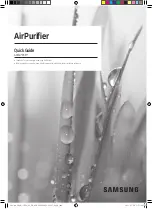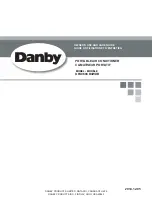
81
Scrolling Marquee Display
This device is the keypad interface used to access rooftop
information, read sensor values, and test the unit. (See Fig. 49.)
The Scrolling Marquee display is a 4-key, 4-character, 16-segment
LED (light-emitting diode) display. Eleven mode LEDs are located
on the display as well as an Alarm Status LED. See Basic Control
Usage section for further details.
Accessory Navigator
t
Display
The accessory hand-held Navigator display can be used with
48/50PG and PM units. (See Fig. 50.) The Navigator display
operates the same way as the Scrolling Marquee device. The
Navigator display plugs into the LEN port on either TB or the
ECB board.
Run Status
Service Test
Temperature
Pressures
Setpoints
Inputs
Outputs
Configuration
Time Clock
Operating Modes
Alarms
Alarm Status
ENTER
MODE
ESCAPE
C06320
Fig. 49 -- Scrolling Marquee
Run Sta
tus
Service
Test
Temper
ature
s
Pres
sures
Setpo
ints
Inputs
Outp
uts
Config
uration
Time C
lock
Operating
Modes
Alarm
s
E NTE
R
E S C
M O D
E
Alarm
Sta
tus
TIME
EWT
LWT
SETP
1 2 . 5 8
5 4 . 6
°
F
4 4 . 1
°
F
4 4 . 0
°
F
N A V
I G A
T O R
C o m f o
r t
L i n k
C06321
Fig. 50 -- Accessory Navigator
t
Display
Carrier Comfort Network (CCN)
R
Interface
The units can be connected to the CCN if desired. The
communication bus wiring is a shielded, 3-conductor cable with
drain wire and is field supplied and installed. The system elements
are connected to the communication bus in a daisy chain
arrangement. (See Fig. 51.) The positive pin of each system
element communication connector must be wired to the positive
pins of the system elements on either side of it. This is also
required for the negative and signal ground pins of each system
element. Wiring connections for CCN should be made at TB. (See
Fig. 28.) Consult the CCN Contractor’s Manual for further
information.
NOTE
: Conductors and drain wire must be 20 AWG (American
Wire Gauge) minimum stranded, tinned copper. Individual
conductors must be insulated with PVC, PVC/nylon, vinyl, Teflon,
or polyethylene. An aluminum/polyester 100% foil shield and an
outer jacket of PVC, PVC/nylon, chrome vinyl, or Teflon with a
minimum operating temperature range of –20
_
C to 60
_
C is
required. See Table below for acceptable wiring.
MANUFACTURER
PART NO.
Alpha
2413 or 5463
Belden
8772
Carol
C2528
West Penn
302
It is important when connecting to a CCN communication bus that
a color-coding scheme be used for the entire network to simplify
the installation. It is recommended that red be used for the signal
positive, black for the signal negative and white for the signal
ground. Use a similar scheme for cables containing different
colored wires.
At each system element, the shields of its communication bus
cables must be tied together. The shield screw on TB1 can be used
to tie the cables together. If the communication bus is entirely
within one building, the resulting continuous shield must be
connected to a ground at one point only. The shield screw on TB1
is not acceptable for grounding. If the communication bus cable
exits from one building and enters another, the shields must be
connected to grounds at the lightning suppressor in each building
where the cable enters or exits the building (one point per building
only). To connect the unit to the network:
1. Turn off power to the control box.
2. Cut the CCN wire and strip the ends of the red (+), white
(ground), and black (–) conductors. (Substitute appropriate
colors for different colored cables.)
3. Connect the red wire to (+) terminal on TB1, the white wire
to COM terminal, and the black wire to the (–) terminal.
4. The RJ14 CCN connector on TB1 can also be used, but is
only intended for temporary connection (for example, a
laptop computer running Carrier network software).
5. Restore power to unit.
IMPORTANT
: A shorted CCN bus cable will prevent some
routines from running and may prevent the unit from starting. If
abnormal conditions occur, unplug the connector. If conditions
return to normal, check the CCN connector and cable. Run new
cable if necessary. A short in one section of the bus can cause
problems with all system elements on the bus.
48/
50P
G
and
P
M
Содержание 48/50PG Series
Страница 32: ...32 C07009 Fig 20 Air Baffle Dimensions 48 50PG03 16 48 50PG and PM...
Страница 33: ...33 C08077 Fig 21 Air Baffle Dimensions 48 50PG20 28 and 48 50PM16 28 48 50PG and PM...
Страница 58: ...58 C08549 Fig 28 48PG03 16 Control Wiring Schematic 48 50PG and PM...
Страница 59: ...59 C08550 Fig 29 50PG03 16 Control Wiring Schematic 48 50PG and PM...
Страница 60: ...60 C08551 Fig 30 Typical 48 50PG03 16 Power Wiring Schematic and Legend 48 50PG16 460 3 60 Shown 48 50PG and PM...
Страница 64: ...64 C08471 Fig 34 Typical 48PG and PM16 28 Control Schematic 48PM16 28 Shown 48 50PG and PM...
Страница 66: ...66 C08557 Fig 36 Typical 50PG and PM16 28 Control Schematic 50PG20 28 Shown 48 50PG and PM...
Страница 67: ...67 C08064 Fig 37 Typical 50PG and PM16 28 with Humidi MiZert Control Schematic 50PM16 28 Shown 48 50PG and PM...
Страница 68: ...68 C08558 Fig 38 Typical 48 50PG and PM16 28 Power Schematic 48 50PM16 28 Shown 48 50PG and PM...
Страница 72: ...72 C08565 Fig 42 Typical 48 50PG20 28 Component Arrangement 48 50PG20 24 Shown 48 50PG and PM...
Страница 73: ...73 C08067 Fig 43 48 50PM16 28 Component Arrangement 48 50PG and PM...
Страница 74: ...74 C08562 Fig 44 48 50PM16 28 with Humidi MiZert Component Arrangement 48 50PG and PM...
Страница 208: ...208 48 50PG and PM...
















































